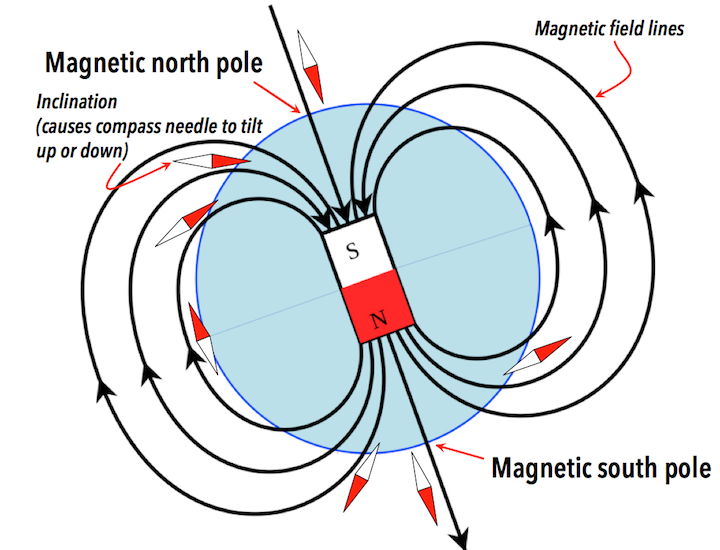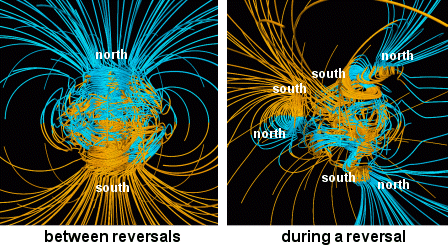3.4 Earth’s Magnetic Field
Earth’s liquid iron core convects because it is heated from beneath by the inner core. Because iron is a metal and conducts electricity (even when molten), its motion generates a magnetic field.
Earth’s magnetic field is defined by north and south poles representing lines of magnetic force flowing into Earth in the northern hemisphere and out of Earth in the southern hemisphere (Figure 3.15). Because of the shape of the field lines, the magnetic force is oriented at different angles to the surface in different locations. The tilt, or inclination of magnetic field lines is represented by the tilt of compass needles in Figure 3.15. At the north and south poles, the force is vertical. The force is horizontal at the equator. Everywhere in between, the magnetic force is at an intermediate angle to the surface.

Exercise: Magnetic Inclination
Regular compasses point only to the north magnetic pole, but if you had a magnetic dip meter (or a smartphone with the appropriate app), you could also measure the angle of the magnetic field at your location in the up-and-down sense. However, you don’t need a dip meter or app to do this exercise!
Using Figure 3.15 as a guide, describe the general location on Earth where the vertical angles would be as follows:
- Straight down
- Down at a steep angle
- Up at a steep angle
- Parallel to flat ground
Earth’s magnetic field is generated within the outer core by the convective movement of liquid iron, but although convection is continuous, the magnetic field is not stable. Periodically, the magnetic field decays and then becomes re-established. When it does re-establish, the polarity may have reversed (i.e., your compass would point south rather than north). Over the past 250 Ma, there have been hundreds of magnetic field reversals, and their timing has been anything but regular. The shortest ones that geologists have been able to identify lasted only a few thousand years, and the longest one was more than 30 million years, during the Cretaceous Period (Figure 3.16).

Changes in Earth’s magnetic field have been studied using mathematical models that simulate convection in the outer core (Figure 3.17). Reversals happened spontaneously when the model was run to simulate a period of several hundred thousand years. Spontaneous reversals can happen because convection does not occur in an orderly way, in spite of what the bar magnet analogy may suggest. Many small-scale variations occur in convection patterns within the inner core, and Earth’s magnetic field over all is the sum of those variations. Magnetic reversals do not happen as frequently as they might, if not for the solid inner core. Magnetic field changes take much longer within the inner core, so reversals in the outer core do not always coincide with reversals in the inner core. Both are required in order for Earth’s magnetic field to flip.

References
British Geological Survey, Natural Environment Research Council (n.d.). Reversals: Magnetic Flip. Visit website
Glatzmaier, G. A. (n.d.) The Geodynamo. Visit website

